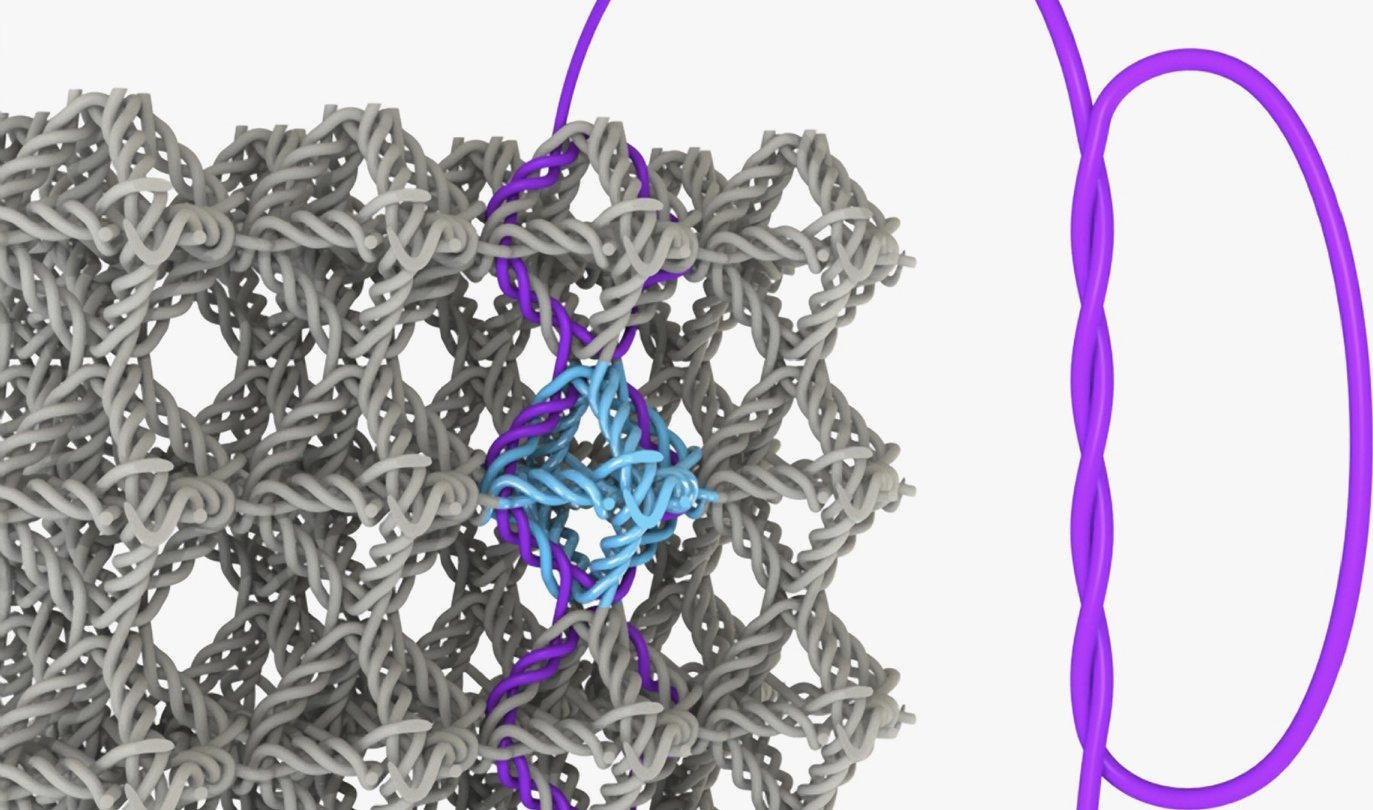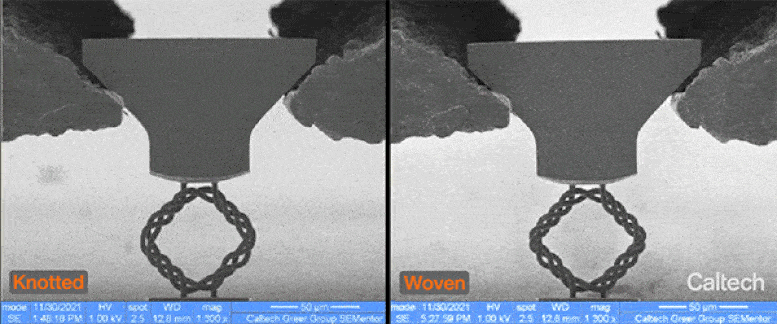
I materiali complessi, costruiti con polimeri, mostrano una resistenza alla trazione di gran lunga superiore ai materiali semplici ma strutturalmente identici, compresi i materiali in cui i singoli filamenti sono intrecciati anziché annodati. Credito: California Institute of Technology
Gli ingegneri del Caltech hanno compiuto un importante passo avanti nel campo dei materiali nano e nano ingegnerizzati creando un nuovo materiale costituito da molti nodi infinitesimali interconnessi.
Rispetto a materiali strutturalmente simili ma che non si incastrano, la presenza di nodi in questo nuovo materiale ne aumenta notevolmente la durata consentendogli di assorbire più energia e deformarsi maggiormente prima di tornare alla sua forma originale senza alcun danno. Questi nuovi materiali complessi possono trovare applicazioni in biomedicina e in applicazioni aerospaziali grazie alla loro robustezza, potenziale biocompatibilità ed elevata deformabilità.
La capacità di superare il compromesso generale tra deformazione del materiale e tenacità a trazione [the ability to be stretched without breaking] offre nuovi modi per progettare dispositivi flessibili, altamente durevoli e in grado di funzionare in condizioni estreme “, afferma l’ex studente laureato al Caltech Widianto P. Moestopo è l’autore principale di un articolo su[{” attribute=””>nanoscale knots that was published on March 8 in Science Advances.
Moestopo helped develop the material in the lab of Julia R. Greer, the Ruben F. and Donna Mettler Professor of Materials Science, Mechanics and Medical Engineering; Fletcher Jones Foundation director of the Kavli Nanoscience Institute; and senior author of the Science Advances paper. Greer is at the forefront of the creation of such nano-architected materials, or materials whose structure is designed and organized at a nanometer scale and that consequently exhibit unusual, often surprising properties.

The tensile strength of a material constructed with microscale knots (left), compared to that of a material that lacks knots but is otherwise structurally identical (right). Credit: Caltech
“Embarking on understanding how the knots would affect the mechanical response of micro-architected materials was a new out-of-the-box idea,” Greer says. “We had done extensive research on studying the mechanical deformation of many other types of micro-textiles, for example, lattices and woven materials. Venturing into the world of knots allowed us to gain deeper insights into the role of friction and energy dissipation, and proved to be meaningful.”
Each knot is around 70 micrometers in height and width, and each fiber has a radius of around 1.7 micrometers (around one-hundredth the radius of a human hair). While these are not the smallest knots ever made—in 2017 chemists tied a knot made from an individual strand of atoms—this does represent the first time that a material composed of numerous knots at this scale has ever been created. Further, it demonstrates the potential value of including these nanoscale knots in a material—for example, for suturing or tethering in biomedicine.
The knotted materials, which were created out of polymers, exhibit a tensile toughness that far surpasses materials that are unknotted but otherwise structurally identical, including ones where individual strands are interwoven instead of knotted. When compared to their unknotted counterparts, the knotted materials absorb 92 percent more energy and require more than twice the amount of strain to snap when pulled.
The knots were not tied but rather manufactured in a knotted state by using advanced high-resolution 3D lithography capable of producing structures in the nanoscale. The samples detailed in the Science Advances paper contain simple knots—an overhand knot with an extra twist that provides additional friction to absorb additional energy while the material is stretched. In the future, the team plans to explore materials constructed from more complex knots.
Moestopo’s interest in knots grew out of research he was conducting in 2020 during the COVID-19 lockdowns. “I came across some works from researchers who are studying the mechanics of physical knots as opposed to knots in a purely mathematical sense. I do not consider myself a climber, a sailor, or a mathematician, but I have tied knots throughout my life, so I thought it was worth trying to insert knots into my designs,” he says.
Reference: “Knots are not for naught: Design, properties, and topology of hierarchical intertwined microarchitected materials” by Widianto P. Moestopo, Sammy Shaker, Weiting Deng and Julia R. Greer, 8 March 2023, Science Advances.
DOI: 10.1126/sciadv.ade6725
The study was funded by the National Science Foundation through Moestopo’s Graduate Research Fellowship Program, Caltech’s Clinard Innovation Fund, Greer’s Vannevar Bush Faculty Fellowship, and the Office of Naval Research.

“Devoto esploratore. Pluripremiato sostenitore del cibo. Esasperante umile fanatico della tv. Impenitente specialista dei social media.”



More Stories
Il rover Perseverance della NASA ha trovato una roccia su Marte che potrebbe indicare la vita antica
Vuoi cucinare come un Neanderthal? Gli archeologi scoprono segreti
L’aurora boreale potrebbe brillare in alcuni stati stasera